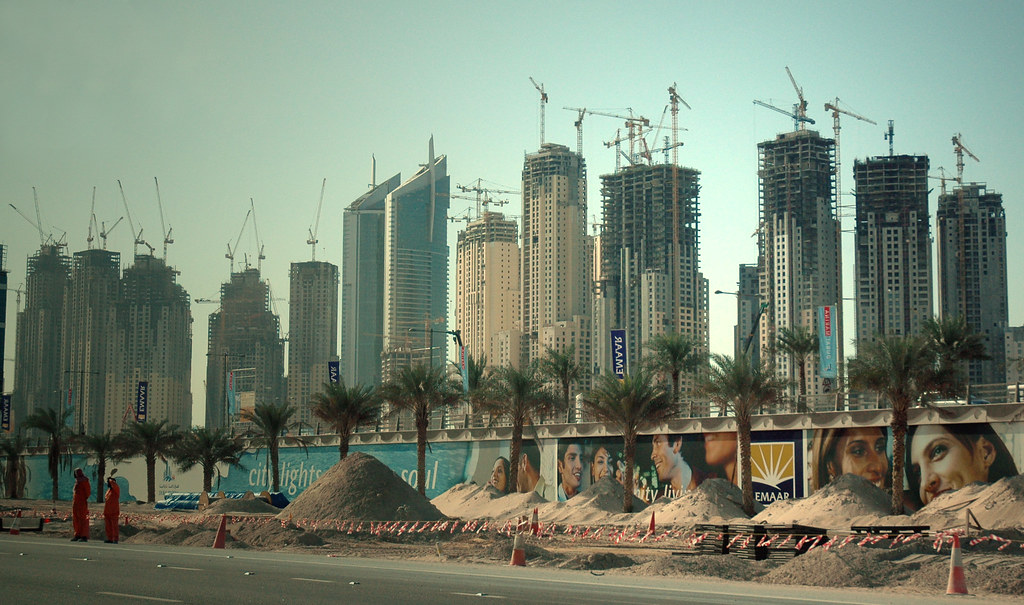

Each week we will be focusing on blogs from around the world dealing specifically with urban environments. We’ll be on the lookout for websites outside the country that approach themes related to urban experiences and issues.
– – – – – – – – – – – – – – – – – – – – – –
• CityCenter, Las Vegas’ newest mega-project, debuts to the public next week. Designed by 8 notable architects to function as a city in-itself, the $8.5 billion, 67-acre, glass-and-steel structure is home to several luxury hotels, a major retail complex and, (of course) a casino.
• Dubai’s spending spree on massive infrastrucutre and architectural projects is likely over as the city now risks defaulting on its payments. The global economic downturn has left Dubai with a crushing debt. The city’s state-owned development company, Dubai World, asked creditors last week for a 6-month standstill on approximately $26 billion of debt.
• A new pedestrian bridge in Mina, Saudi Arabia (about two miles from Mecca), safely accommodated the more than 2 million pilgrims who crossed over it last Saturday. The pilgrims were re-enacting the Prophet Abraham’s rejection of the devils temptation as part of the Muslim ritual Jamarat. The $1.2 billion, five-story bridge has dramatically decreased congestion on a site which has previously witnessed multiple deaths resulting from stampeding crowds.
• After reviewing a flood of entries from around the world, Project for Public Spaces, features an in-depth profile on 9 of the world’s greatest streets and the reasons they work.
Photo of Dubai by Jake Brewer

One comment
Is it possible to have a socially responsible urban infrastructural boom?
For instance, Dubai with its architectural wonders, not only overspent, it underpaid and mistreated the migrant workers who did the work. We reify the architecture and the feats and we ignore the cost of castles in the sand. The photo in this post, if it is from Dubai (no caption so cannot tell!), reminds me of scenes in Terry Gilliam’s Brazil.
Then there is Las Vegas built by the mob and our insatiable desire for vice masked in an experience economy mirage. More people living on piped in water – the manufacturing of an oasis.
And the Saudi infrastructure of religion, one that builds bridges for pilgrims while disallowing 51% of its population full participation in society.
Slaves and skyscrapers: The workforce feeling the heat (excerpt from UK Independent article: Sacked by Text the Indian workers who built Dubai – http://www.independent.co.uk/news/world/middle-east/sacked-by-text-the-indian-workers-who-built-dubai-1831651.html).
“The UAE’s huge construction boom of recent years has been fuelled largely by south Asian migrant construction workers, who work in the grimmest of circumstances. Human Rights Watch estimated in 2006 that at least half a million migrants are paid a little over £100 a month for their work in a country where the average per capita monthly income is close to £1,300. There is no indication that their circumstances have improved since. Migrants can end up working 12 hours a day or longer, six days a week, in fierce heat. In 2005, the Indian Consulate registered 971 deaths of its own nationals, at which point it was told to stop counting. Suicide among the men is rife, with 100 or more of them dying by their own hands in 2007. Such conditions come as a grim surprise for newcomers lured by agencies with promises of lavish pay, only to find their passports confiscated, wages slashed and huge debts owed. And they form a sharp contrast to the lives of the wealthy western ex-pats in finance, IT and tourism – 50,000 to 150,000 of them, on vast tax-free salaries.”